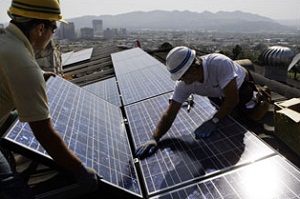forum
library
tutorial
contact

Energy Policy in the U.S.:
Does Solar Power Stand a Chance?
by Brittany Mauriss
Ecopolitology, August 3, 2011
|
the film forum library tutorial contact |

|
Energy Policy in the U.S.:
by Brittany Mauriss
|
It's the "political, social, and economic interests" that are and will be the largest obstacle
 Solar power: it's clean, renewable and becoming more cost-effective every day. But in a political landscape so mired by fossil fuels that our government has gifted Big Oil over $150 billion in tax breaks and subsidies since 1950, solar power's progress has been slow-going, to say the least.
Solar power: it's clean, renewable and becoming more cost-effective every day. But in a political landscape so mired by fossil fuels that our government has gifted Big Oil over $150 billion in tax breaks and subsidies since 1950, solar power's progress has been slow-going, to say the least.
And yet, the amount of federal, state, and local incentives for solar installations have grown exponentially over the past 15 years. Where a 4-kilowatt home solar array would have cost you $600,000 in 1970, that figure has dropped dramatically to about $18,000 today.
Think about that for a second. Although there's still a long road ahead in turning the country away from environmentally-toxic energy sources to solar panels, wind turbines and hydroelectric power, we've made a small but very real impact in American energy distribution.
What would it take to wean the U.S. off fossil fuels?
The short answer: a whole lot.
And ostensibly, the task looks ominously daunting. But let's consider New York City, one of the largest cities in the world in terms of population and energy consumption.
New York City collectively uses about 50 million MW (that's mega, as in millions of watts), or roughly enough power to blast the Earth clear across the Milky Way. However -- and this'll come as a surprise to many -- New York City is actually one of most energy-efficient large cities worldwide, with its residents consuming around 5,000 kWh (kilowatt hours per hour) per capita, per year. Contrast that with cities like Dallas (metro population: 6.5m) and San Francisco (7.4m), which use, respectfully, 16,000kWh and 7,100 kWh per capita, per year. And those cities have fewer inhabitants than New York.
That leads to the larger point -- that ubiquitous solar power on a massive scale is possible, but still years, maybe decades, away. Since solar technology is relatively expensive (though not nearly as much as only 15 years ago), we need a solution that combines the best of all worlds of renewable energies, including solar, wind, nuclear, geothermal, hydro, and especially those technologies yet to be discovered.
Hurdles to overcome and initiatives to take
Switching to 100% renewable, clean energy by, say, 2030 is possible. Even most scientists and experts in the realm of engineering and energy studies will concede that. We have the resources -- it's the will of the public, the federal and state governments, and of companies (not to mention, funding) that's severely lacking.
According to Physorg.com, Mark Delucchi and Mark Jacobson, two internationally recognized professors of science and engineering at Stanford University, adamantly maintain that universal solar power can be achieved. According to them, a grand mixture of PV panels, powerful, offshore wind turbines, geothermal pumps, and hydropower is needed.
And America has the technologies and materials. It's the "political, social, and economic interests" that are and will be the largest obstacle in transforming the U.S., as well as the earth, into a place free of fossil fuel-powered energy (of which 80% of the world currently relies on).
Tax Incentives and Rebates in America
Although national policy has a long way to go, there are still a plethora of federal, state and local incentives to cut the costs of home solar. The largest is the federal tax credit for up to 30% off qualifying solar panel installations through 2016.
Your state may also provide cash rebates, often administered through your local utility. Los Angeles rebates, which ran out due to overwhelming demand, are currently in the process of being reinstated, and Oakland, CA still offers one of the most generous incentive packages (totaling about 60% off your solar system). Depending on where you live, your system could be largely paid for by the government, slimming your payback period on solar to 2-5 years.
Even with homeowner incentives, solar power faces an uphill battle. Oil and coal interests are deeply entrenched in our political system, but the more individuals make the switch to renewable energy on the local level, the sooner our leaders will follow suit -- passing legislation that dismantles rather than perpetuates the cycle of earth-damaging energy production in the U.S.
Here's to inspiring progress from the rooftop up.
Related Pages:
BPA Sets 7.8-Percent Average Rate Increase by Ben Tansey, NW Fishletter, 8/5/11
Energy NW Nuclear Power Restart Delayed Again by Annette Cary, Tri-City Herald, 8/3/11
learn more on topics covered in the film
see the video
read the script
learn the songs
discussion forum
